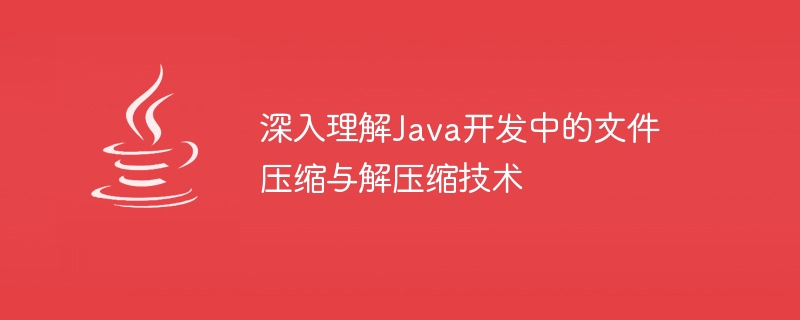
深入理解Java開發中的檔案壓縮與解壓縮技術
隨著網路的高速發展與資訊科技的日新月異,大量的資料交換與傳輸已成為當今社會的常態。為了有效率地儲存和傳輸數據,文件壓縮與解壓縮技術應運而生。在Java開發中,檔案壓縮與解壓縮是一個必備的技能,本文將深入探討這項技術的原理與使用方法。
一、文件壓縮與解壓縮的原理
在電腦中,文件壓縮就是將一個或多個文件通過使用特定的演算法,將文件的大小縮小,並產生一個包含了原始文件內容的壓縮檔案。而解壓縮則是將這個壓縮檔還原成原始檔。檔案壓縮的核心原理通常有兩種方式:無損壓縮和有損壓縮。
二、Java中的檔案壓縮與解壓縮技術
Java語言提供了許多壓縮和解壓縮的類別庫和API,可以方便地進行檔案壓縮和解壓縮作業。以下將介紹兩種常用的壓縮和解壓縮技術:gzip和zip。
import java.io.FileInputStream;
import java.io.FileOutputStream;
import java.io.IOException;
import java.util.zip.GZIPInputStream;
import java.util.zip.GZIPOutputStream;
public class GZipExample {
public static void compressFile(String sourceFile, String compressedFile) throws IOException {
byte[] buffer = new byte[1024];
FileInputStream fis = new FileInputStream(sourceFile);
FileOutputStream fos = new FileOutputStream(compressedFile);
GZIPOutputStream gos = new GZIPOutputStream(fos);
int length;
while ((length = fis.read(buffer)) > 0) {
gos.write(buffer, 0, length);
}
fis.close();
gos.finish();
gos.close();
fos.close();
}
public static void decompressFile(String compressedFile, String decompressedFile) throws IOException {
byte[] buffer = new byte[1024];
FileInputStream fis = new FileInputStream(compressedFile);
GZIPInputStream gis = new GZIPInputStream(fis);
FileOutputStream fos = new FileOutputStream(decompressedFile);
int length;
while ((length = gis.read(buffer)) > 0) {
fos.write(buffer, 0, length);
}
fis.close();
gis.close();
fos.close();
}
public static void main(String[] args) throws IOException {
String sourceFile = "input.txt";
String compressedFile = "compressed.gzip";
String decompressedFile = "output.txt";
compressFile(sourceFile, compressedFile);
decompressFile(compressedFile, decompressedFile);
}
}import java.io.FileInputStream;
import java.io.FileOutputStream;
import java.io.IOException;
import java.util.zip.ZipEntry;
import java.util.zip.ZipInputStream;
import java.util.zip.ZipOutputStream;
public class ZipExample {
public static void compressFile(String sourceFile, String compressedFile) throws IOException {
byte[] buffer = new byte[1024];
FileOutputStream fos = new FileOutputStream(compressedFile);
ZipOutputStream zos = new ZipOutputStream(fos);
ZipEntry ze = new ZipEntry(sourceFile);
zos.putNextEntry(ze);
FileInputStream fis = new FileInputStream(sourceFile);
int length;
while ((length = fis.read(buffer)) > 0) {
zos.write(buffer, 0, length);
}
fis.close();
zos.closeEntry();
zos.close();
fos.close();
}
public static void decompressFile(String compressedFile, String decompressedFile) throws IOException {
byte[] buffer = new byte[1024];
ZipInputStream zis = new ZipInputStream(new FileInputStream(compressedFile));
ZipEntry ze = zis.getNextEntry();
FileOutputStream fos = new FileOutputStream(decompressedFile);
int length;
while ((length = zis.read(buffer)) > 0) {
fos.write(buffer, 0, length);
}
zis.closeEntry();
zis.close();
fos.close();
}
public static void main(String[] args) throws IOException {
String sourceFile = "input.txt";
String compressedFile = "compressed.zip";
String decompressedFile = "output.txt";
compressFile(sourceFile, compressedFile);
decompressFile(compressedFile, decompressedFile);
}
}三、總結
透過本文的介紹,我們詳細了解了檔案壓縮與解壓縮的原理以及在Java開發中如何進行檔案壓縮與解壓縮的操作。無論是透過GZIP或ZIP,Java提供了豐富的類別庫和API來滿足不同場景下的需求。合理應用檔案壓縮和解壓縮技術,可以提高系統的效能和反應速度,同時減少資料的儲存和傳輸空間。希望本文能為讀者提供Java文件壓縮和解壓縮技術的深入理解,幫助讀者在實際開發中運用這項技術。
以上是深入理解Java開發中的檔案壓縮與解壓縮技術的詳細內容。更多資訊請關注PHP中文網其他相關文章!




